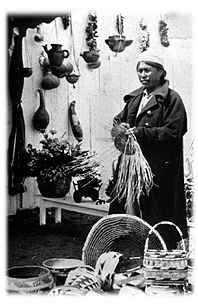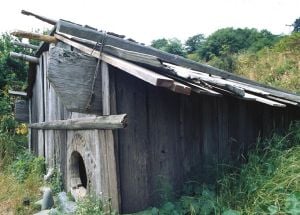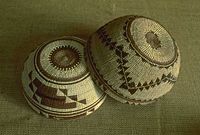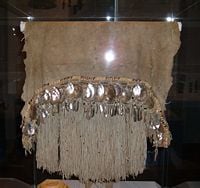Difference between revisions of "Yurok (tribe)" - New World Encyclopedia
| Line 42: | Line 42: | ||
[[Image:Yurok dance skirt 1 CAC.JPG|thumb|200 px|left|Yurok, Karuk dance skirt (late 1800s) made of leather, abalone, pine nuts, beads, and metal on display at the Iris & B. Gerald Cantor Center for Visual Arts on the Stanford University campus in Stanford, California.]] | [[Image:Yurok dance skirt 1 CAC.JPG|thumb|200 px|left|Yurok, Karuk dance skirt (late 1800s) made of leather, abalone, pine nuts, beads, and metal on display at the Iris & B. Gerald Cantor Center for Visual Arts on the Stanford University campus in Stanford, California.]] | ||
Yurok traditional narratives include [[myth]]s, [[legend]]s, tales, and oral histories preserved by the Yurok people. Their oral literature, together with the similar narratives of the [[Karuk]] and [[Hupa]], constitutes a distinctive variant within Native California, with significant links with the [[Northweat Coast Indians|tribes of the Northwest Coast]]. However, they did not practice the traditional [[potlatch]], masked dancing, or [[totem pole]] carving typical of the Northwest Coast tribes. | Yurok traditional narratives include [[myth]]s, [[legend]]s, tales, and oral histories preserved by the Yurok people. Their oral literature, together with the similar narratives of the [[Karuk]] and [[Hupa]], constitutes a distinctive variant within Native California, with significant links with the [[Northweat Coast Indians|tribes of the Northwest Coast]]. However, they did not practice the traditional [[potlatch]], masked dancing, or [[totem pole]] carving typical of the Northwest Coast tribes. | ||
| + | |||
| + | Traditional Yurok beliefs involved rituals to engage [[supernatural]] aid for [[healing]] and for public welfare. | ||
| + | Yurok, as did Karuk and Hupa, practiced the World Renewal ceremonies. These rituals were intended to maintain the natural world and to ensure a continuation of the earth's resources—providing food and promoting tribal well-being. They also afforded opportunities for displays of [[wealth]] and elaborate costuming. Dancers in the White Deerskin dance wore regalia of [[deer]] hide or [[civet cat]], [[dentalium|dentalia]] necklaces, and [[wolf]]-fur bands around their forehead, while carrying poles mounted with stuffed deer heads. The Jump Dance regalia included a headdress consisting of large [[woodpecker]] scalps, long white feathers, strings of dentalia, and a deerskin robe. | ||
Yurok spirituality can be understood as an arena in which: | Yurok spirituality can be understood as an arena in which: | ||
<blockquote>... individual and society meet in dialogue—cooperating, resisting, negotiating, changing each other in manifold ways. 'Culture,' here, is not a thing but a process, and emergence through time (Buckley 2002).</blockquote> | <blockquote>... individual and society meet in dialogue—cooperating, resisting, negotiating, changing each other in manifold ways. 'Culture,' here, is not a thing but a process, and emergence through time (Buckley 2002).</blockquote> | ||
| − | |||
| − | |||
| − | |||
[[Shaman]]s were believed to have the power to cure [[disease]]; this power being given only to women. The Brush dance is a special ceremony held to heal a sick child. Conducted by the shaman, the family of the sick person hosted the dance which often took place in their home, the roof of the plank house being removed. Members of the tribe, and other local tribes would participate, or just spectate, as the dance continued all night. | [[Shaman]]s were believed to have the power to cure [[disease]]; this power being given only to women. The Brush dance is a special ceremony held to heal a sick child. Conducted by the shaman, the family of the sick person hosted the dance which often took place in their home, the roof of the plank house being removed. Members of the tribe, and other local tribes would participate, or just spectate, as the dance continued all night. | ||
Revision as of 22:32, 18 September 2008
| Yurok |
|---|

|
| Basketweaver of the Yurok people |
| Total population |
| 5,000+ |
| Regions with significant populations |
| California |
| Languages |
| Yurok, English |
| Religions |
| Shamanism, Christianity |
| Related ethnic groups |
| Karuk, Hupa |
The Yurok, whose name means "downriver people," are Native Americans whose ancestors have long lived along the Klamath River near the Pacific Ocean coast of Northern California, United States. They are known as fishermen, basket weavers, canoe makers, storytellers, dancers, and healers.
Following encounters with white settlers moving into their aboriginal lands during a gold rush in 1850, the Yurok were faced with disease and massacres that reduced their population by 75 percent. In 1855, most of those that remained were forcibly relocated to the Yurok Indian Reservation on the Klamath River.
History
Estimates for the pre-contact populations of most native groups in California have varied substantially, with those for the Yurok ranging from 2,500 (Kroeber 1925, 883) to 3,100 (Cook 1956, 84). By 1870, the Yurok population had declined to 1,350 (Cook 1976, 237) and by 1910 it was reported as 668 or 700 (Cook 1976, 237; Kroeber 1925, 883).
First contact was with Spanish explorers in the sixteenth century, but no continuous interaction occurred until the nineteenth century when American expeditions began to trade for furs. Reports from Jedediah Smith's expeditions resulted in an increase in the number of trappers exploring and settling the area from the 1820s.
The California gold rush led to great numbers of settlers moving to the area in 1849. Mining efforts led to destruction of villages and encounters led to hostilities. By the end of the gold rush era, at least 75 percent of the Yurok had perished due to conflict or disease and the Yurok lost most of their land.
In 1855 the Yurok Reservation was established in an area considerably smaller than their ancestral territory, and Yurok people were required to stay within its boundaries. With the establishment of Fort Terwer, Yurok were forced to learn English. When the fort was destroyed, Yurok children were sent to live at the Hoopa Valley Reservation and were taught by missionaries at boarding schools. They not only imposed English language but also Christian beliefs and culture. Children were punished for using the Yurok language and observing traditional ways. This period was one in which the Yurok language and culture almost became extinct.
Culture
The Klamath River and the redwood tree have been central to their culture. Their family homes and sweathouses were made from the redwood, as were their canoes. The redwood was regarded as a sacred living creature, to be revered and respected as well as put into service for the good of the tribe. The Yurok aare also skilled at basketry (O'Neale 2007).
Traditionally, dentalia shells harvested from the ocean were used for money, and as ceremonial decorations. Acquiring wealth was important, and the Yurok, unlike other Native Americans, had individual ownership of land. Land was counted as wealth, and could be sold to one another (Waldman 2006).
Language
The traditional language of the Yurok, known as Yurok (also Weitspekan) is an endangered Algic language. The standard reference on the Yurok language is the grammar by Robins (1958). The great majority of Yurok now speak English. As of 2000 among the speakers of the Yurok language were 75 individuals between the ages of 5 and 17, including 10 with limited English proficiency.
Religion
Yurok traditional narratives include myths, legends, tales, and oral histories preserved by the Yurok people. Their oral literature, together with the similar narratives of the Karuk and Hupa, constitutes a distinctive variant within Native California, with significant links with the tribes of the Northwest Coast. However, they did not practice the traditional potlatch, masked dancing, or totem pole carving typical of the Northwest Coast tribes.
Traditional Yurok beliefs involved rituals to engage supernatural aid for healing and for public welfare. Yurok, as did Karuk and Hupa, practiced the World Renewal ceremonies. These rituals were intended to maintain the natural world and to ensure a continuation of the earth's resources—providing food and promoting tribal well-being. They also afforded opportunities for displays of wealth and elaborate costuming. Dancers in the White Deerskin dance wore regalia of deer hide or civet cat, dentalia necklaces, and wolf-fur bands around their forehead, while carrying poles mounted with stuffed deer heads. The Jump Dance regalia included a headdress consisting of large woodpecker scalps, long white feathers, strings of dentalia, and a deerskin robe.
Yurok spirituality can be understood as an arena in which:
... individual and society meet in dialogue—cooperating, resisting, negotiating, changing each other in manifold ways. 'Culture,' here, is not a thing but a process, and emergence through time (Buckley 2002).
Shamans were believed to have the power to cure disease; this power being given only to women. The Brush dance is a special ceremony held to heal a sick child. Conducted by the shaman, the family of the sick person hosted the dance which often took place in their home, the roof of the plank house being removed. Members of the tribe, and other local tribes would participate, or just spectate, as the dance continued all night.
Contemporary Yurok
The US Census for the year 2000 indicated that there were 4,413 Yurok living in California, combining those of one tribal descent and those with ancestors of several different tribes and groups. There were 5,793 Yurok living in all of the United States.
The Yurok Indian Reservation is located in parts of Del Norte and Humboldt Counties, California on a 44-mile stretch of the Klamath River. The size of the reservation is 219.408 km² (84.714 sq mi), and with almost 5,000 enrolled members, the Yurok Tribe is California's largest Indian Tribe. The reservation is serviced by Highway 169 from the south, which dead ends within the reservation. It is bordered by the Hoopa Indian Reservation to the south. It is adjacent to Redwood National Park to the west. The 2000 census reported a resident population of 1,103 persons on reservation territory, mostly in the community of Klamath, at the reservation's north end.
Despite the dark period of Yurok history in which their language and culture was suppressed, almost to extinction, revitalization occurred in the latter part of the twentieth century.
Efforts have been made to revive the apparently moribund Yurok language. The Yurok Tribe developed a language program in the 1990s, using old recordings of native speakers as well as the few remaining native speakers to teach young people. The Yurok Language Project, established at University of California Berkeley, with the goal of contributing language-learning material to Yurok language revitalization programs sponsored by the Yurok Tribe language office and others, both on and off the reservation. They have gathered material on the Yurok language together into a single digital archive, incorporating material from as early as 1850 to the present day. They also published a dictionary in 2005. Much of the material is available on the internet.
The knowledge and beliefs of the Yurok have also re-emerged. Traditional dances, such as the Brush Dance for healing, the Jump Dance and the White Deerskin Dance, two of the most sacred religious ceremonies and part of the World Renewal cycle, are now held in several communities.
ReferencesISBN links support NWE through referral fees
- Buckley, Thomas. 2002. Standing Ground: Yurok Indian Spirituality, 1850-1990. Berkeley, CA: University of California Press. ISBN 978-0520233898
- Cook, Sherburne F. 1956. "The Aboriginal Population of the North Coast of California." Anthropological Records 16: 81-130.
- Cook, Sherburne F. 1976. The Conflict between the California Indian and White Civilization. Berkeley, CA: University of California Press. ISBN 0520031431
- Kroeber, A. L. [1925] 1976. Handbook of the Indians of California (Bureau of American Ethnology Bulletin 78). Dover Publications. ISBN 0486233685
- Robins, Robert H. 1958. The Yurok Language: Grammar, Texts, Lexicon. Berkeley, CA: University of California Publications in Linguistics 15.
- Thompson, Lucy. 1991. To the American Indian: Reminiscences of a Yurok Woman. Heyday Books. ISBN 0930588479
- O'Neale, Lila. [1932] 2007. Yurok-Karok Basket Weavers. Berkeley, CA: Phoebe A. Hearst Museum of Anthropology. ISBN 978-0936127040
- Kroeber A. L. 1978. Yurok Myths. Berkeley, CA: University of California Press. ISBN 0520036395
- Waldman, Carl. 2006. Encyclopedia of Native American Tribes. New York, NY: Checkmark Books. ISBN 978-0816062744.
- Luthin, Herbert W. 2002. Surviving through the Days. Berkeley, CA: University of California Press. ISBN 0520222709
- Curtis, Edward S. [1924] 2007. The North American Indian, Volume 13. Classic Books. ISBN 1404798137. CD-ROM ISBN 140474813X
- Erikson, Erik H. 1943. Observations on the Yurok: Childhood and world image, University of California Publications in American Archaeology and Ethnology 35: 257-301.
- Margolin, Malcolm. [1981] 2001. The Way We Lived: California Indian Stories, Songs, and Reminiscences. Berkeley, CA: Heyday Books. ISBN 093058855X
- Yurok Reservation, California United States Census Bureau. Retrieved September 6, 2008.
External links
- The Yurok Tribe
- "The Northern California Indians" by Stephen Powers (1872)
- Yurok
- Myths and Legends of California and the Old Southwest by Katharine Berry Judson (1912)
- Yurok Culture and History Links
- The North American Indian by Edward S. Curtis (1924)
- Yurok Four Directions Institute
- Yurok Ron Johnson's collection of images
- Yurok Language Project at University of California, Berkeley
Credits
New World Encyclopedia writers and editors rewrote and completed the Wikipedia article in accordance with New World Encyclopedia standards. This article abides by terms of the Creative Commons CC-by-sa 3.0 License (CC-by-sa), which may be used and disseminated with proper attribution. Credit is due under the terms of this license that can reference both the New World Encyclopedia contributors and the selfless volunteer contributors of the Wikimedia Foundation. To cite this article click here for a list of acceptable citing formats.The history of earlier contributions by wikipedians is accessible to researchers here:
- Yurok_(tribe) history
- Yurok_traditional_narratives history
- Yurok_Indian_Reservation history
- Yurok_language history
The history of this article since it was imported to New World Encyclopedia:
Note: Some restrictions may apply to use of individual images which are separately licensed.


